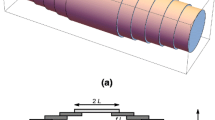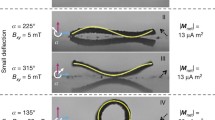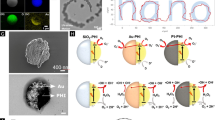Abstract
Microscopic robots could perform tasks with high spatial precision, such as acting in biological tissues on the scale of individual cells, provided they can reach precise locations. This paper evaluates the performance of in vivo locomotion for micron-size robots. Two appealing methods rely only on surface motions: steady tangential motion and small amplitude oscillations. These methods contrast with common microorganism propulsion based on flagella or cilia, which may lead to tangling and increased likelihood of fouling due to the large exposed surface areas. The power potentially available to such robots, as determined by previous studies, supports speeds ranging from one to hundreds of microns per second, over the range of viscosities found in biological tissue. We discuss design trade-offs among propulsion method, speed, power, shear forces and robot shape, and relate those choices to robot task requirements. This study shows that realizing such locomotion requires substantial improvements in fabrication capabilities and material properties over current technology.










Similar content being viewed by others
References
Abbott JJ et al. (2009) How should microrobots swim? Intl J Robot Res 28:1434–1447
Alouges F et al. (2011) Numerical strategies for stroke optimization of axisymmetric microswimmers. Math Model Methods Appl Sci 21:361–387. doi:10.1142/S0218202511005088
Behkam B, Sitti M (2007) Bacterial flagella-based propulsion and on/off motion control of microscale objects. Appl Phys Lett 90:023–902. doi:10.1063/1.2431454
Berg HC (1993) Random Walks in Biology, 2nd edn. Princeton Univ. Press
Blake JR (1971) A spherical envelope approach to ciliary propulsion. J Fluid Mech 46:199–208. 10.1017/S002211207100048X
Brennen C (1974) An oscillating-boundary-layer theory for ciliary propulsion. J Fluid Mech 65:799–824
Brennen C, Winet H (1977) Fluid mechanics of propulsion by cilia and flagella. Ann Rev Fluid Mech 9: 339–398. doi:10.1146/annurev.fl.09.010177.002011
Chan ML et al. (2011) Low friction liquid bearing mems micromotor. Proc of 24th IEEE Intl Conf Micro Electro Mech Syst (MEMS):1237–1240. doi:10.1109/MEMSYS.2011.5734656
Chen BPC et al. (2001) DNA microarray analysis of gene expression in endothelial cells in response to 24-h shear stress. Physiol Genomics 7:55–63
Davies PF (1995) Flow-mediated endothelial mechanotransduction. Physiol Rev 75:519–560
Discher DE, Janmey P, Wang Y (2005) Tissue cells feel and respond to the stiffness of their substrate. Sci 310:1139–1143
Drexler KE (1992) Nanosystems: Molecular Machinery, Manufacturing, and Computation. John Wiley, NY
Dreyfus R et al. (2005) Microscopic artificial swimmers. Nat 437:862–865. doi:10.1038/nature04090
Dusenbery DB (2009) Living at Micro Scale: The Unexpected Physics of Being Small. Harvard Univ. Press. Cambridge, MA
Ehlers K, Oster G (2012) On the mysterious propulsion of Synechococcus. PLoS ONE 7:e36–081. doi:10.1371/journal.pone.0036081
Ehlers KM, Koiller J (2011) Could cell membranes produce acoustic streaming? Making the case for Synechococcus self-propulsion. Math Comput Model 53:1489–1504. doi:10.1016/j.mcm.2010.03.054
Ehlers KM, Koiller J (2011) Micro-swimming without flagella: Propulsion by internal structures. Regular and Chaotic Dynamics 16:623–652. doi:10.1134/S1560354711060050
Ehlers KM, Samuel ADT, Berg HC, Montgomery R (1996) Do cyanobacteria swim using traveling surface waves? Proc. Natl Acad Sci USA 93:8340–8343
Fetter AL, Walecka JD (1980) Theoretical Mechanics of Particles and Continua. McGraw-Hill, New York
Freitas Jr. RA (1998) Exploratory design in medical nanotechnology: A mechanical artificial red cell. Artificial Cells. Blood Substit Immobil Biotechnol 26:411–430
Freitas Jr. R ANanomedicine, vol. I: Basic Capabilities. Landes Bioscience, Georgetown, TX (1999). www.nanomedicine.com/NMI.htm
Freitas Jr. R ANanomedicine, vol. IIA: Biocompatibility. Landes Bioscience, Georgetown, TX (2003). www.nanomedicine.com/NMIIA.htm
Freitas Jr. RA (2006) Pharmacytes: An ideal vehicle for targeted drug delivery. J Nanosci Nanotechnol 6:2769–2775
Freitas Jr. RA (2009) Computational tasks in medical nanorobotics. In: Eshaghian-Wilner M (ed) Bio-inspired and Nano-scale Integrated Computing, chap. 15. John Wiley, NY, pp 391–428
Gao R et al. (2012) Outside looking in: Nanotube transistor intracellular sensors. Nano Lett 12:3329–3333
Guasto JS, Rusconi R, Stocker R (2012) Fluid mechanics of planktonic microorganisms. Annu Rev Fluid Mech 44:373–400. doi:10.1146/annurev-fluid-120710-101156
Happel J, Brenner H (1983) Low Reynolds number hydrodynamics, 2nd edn. Kluwer. The Hague
Hernandez-Ortiz JP, Stoltz CG, Graham MD (2005) Transport and collective dynamics in suspensions of confined swimming particles. Phys Rev Lett 95(204):501
Hill C, Amodeo A, Joseph JV, Patel HRH (2008) Nano- and microrobotics: how far is the reality? Expert Rev Anticancer Ther 8:1891–1897
Hogg T, Freitas Jr. RA (2010) Chemical power for microscopic robots in capillaries. Nanomedicine: Nanotechnol Biol Med 6:298–317. doi:10.1016/j.nano.2009.10.002
Hogg T, Freitas Jr. RA (2012) Acoustic communication for medical nanorobots. Nano Commun Netw 3:83–102. doi:10.1016/j.nancom.2012.02.002
Huang H et al. (2004) Cell mechanics and mechanotransduction: pathways, probes, and physiology. Am J Physiol: Cell Physiol 287:C1–C11. doi:10.1152/ajpcell.00559.2003
Ishikawa T, Pedley TJ (2008) Coherent structures in monolayers of swimming particles. Phys Rev Lett 100:088–103. doi:10.1103/PhysRevLett.100.088103
Ishiyama K, Sendoh M, Arai KI (2002) Magnetic micromachines for medical applications. J Magn Magn Mater 242-245:41–46
Jahn TL, Votta JJ (1972) Locomotion of protozoa. Ann Rev Fluid Mech 4:93–116
Kanevsky A, Shelley MJ, Tornberg AK (2010) Modeling simple locomotors in Stokes flow. J Comput Phys 229:958–977. doi:10.1016/j.jcp.2009.05.030
Keeley A, Soldati D (2004) The glideosome: a molecular machine powering motility and host-cell invasion by Apicomplexa. Trends Cell Biol 14:528–532. doi:10.1016/j.tcb.2004.08.002
Keller SR, Wu TY (1977) A porous prolate-spheroidal model for ciliated micro-organisms. J Fluid Mech 80:259–278
Kim S, Karrila SJ (2005) Microhydrodynamics. Dover
Krim J (2002) Surface science and the atomic-scale origins of friction. Surf Sci 500:741–758
Lai SK, Wang YY, Hanes J (2009) Mucus-penetrating nanoparticles for drug and gene delivery to mucosal tissues. Adv Drug Deliv Rev 61:158–171. doi:10.1016/j.addr.2008.11.002
Lauga E (2009) Powers, T.R.: The hydrodynamics of swimming microorganisms. Rep Prog Phys 72:096–601. doi:10.1088/0034-4885/72/9/096601
Lee C et al. (2008) Measurement of the elastic properties and intrinsic strength of monolayer graphene. Sci 321:385–388. doi:10.1126/science.1157996
Leshansky AM, article (2007) A frictionless microswimmer. New J Phys 9:145. doi:10.1088/1367-2630/9/5/145
Lighthill J (1978) Acoustic streaming. J Sound Vib 61:391–418
Lighthill MJ (1952) On the squirming motion of nearly spherical deformable bodies through liquids at very small reynolds numbers. Commun Pur Appl Math 5:109–118. doi:10.1002/cpa.3160050201
Loheac J et al. (2013) Controllability and time optimal control for low Reynolds numbers swimmers. Acta Applicandae Math 123:175–200
Martel S (2007) The coming invasion of the medical nanorobots. Nanotechno Perceptions 3:165–173
Martel S et al. (2007) Automatic navigation of an untethered device in the artery of a living animal using a conventional clinical magnetic resonance imaging system. Appl Phys Lett 90(114):105
Martel S et al. (2008) Flagellated bacterial nanorobots for medical interventions in the human body. In: Meldrum D, Khatib O (eds) Proc. of 2nd IEEE Conf. on Biomedical Robotics and Biomechatronics, pp 264–269
Menard R (2001) Gliding motility and cell invasion by Apicomplexa: insights from the Plasmodium sporozoite. Cell Microbiol 3:63–73
Michelin S, Lauga E (2010) Efficiency optimization and symmetry-breaking in a model of ciliary locomotion. Fluid Dyn 22:111–901. doi:10.1063/1.3507951
Nelson P (2008) Biological Physics: Energy, Information, Life. W. H. Freeman, NY
Olamaei N, Cheriet F, Beaudoin G, Martel S (2010) MRI visualization of a single 15 μm navigable imaging agent and future microrobot In: Proc. of the 2010 Conf. on Engineering in Medicine and Biology Society, pp. 4355–4358. IEEE
Oliver FWJ et al. (2010) NIST Handbook of Mathematical Functions. Cambridge Univ. Press
Osterman N, Vilfan A (2011) Finding the ciliary beating pattern with optimal efficiency. Proc Natl Acad Sci USA 108:15,727–15,732. doi:10.1073/pnas.1107889108
Papaioannou TG, Stefanadis C (2005) Vascular wall shear stress: Basic principles and methods. Hell J Cardiol 46:9–15
Purcell EM (1977) Life at low Reynolds number. Am J Phys 45:3–11
Riedel IH et al. (2005) A self-organized vortex array of hydrodynamically entrained sperm cells. Sci 309:300–303
Setter E, Bucher I (2010) Elastic travelling waves in multi-dimensional structures with application to self propulsion. In: Sas P, Bergen B (eds) Proc. of Intl. Conf. on Noise and Vibration Engineering (ISMA2010), pp 3785–3800
Shapere A, Wilczek F (1989) Efficiencies of self-propulsion at low Reynolds number. J Fluid Mech 198:587–599. doi:10.1017/S0022112089000261
Shapere A, Wilczek F (1989) Geometry of self-propulsion at low Reynolds number. J Fluid Mech 198:557–585
Soong RK et al. (2000) Powering an inorganic nanodevice with a biomolecular motor. Sci 290:1555–1558
Spagnolie SE, Lauga E (2012) Jet propulsion without inertia. Phys Fluids 22(081):902
Stone HA, Samuel A (1996) Propulsion of microorganisms by surface distortions. Phys Rev Lett 77:4102–4104
Tobias PA, Trindade DC (1986) Applied Reliability. Van Nostrand Reinhold. NY
Trouilloud R et al. (2008) Soft swimming: Exploiting deformable interfaces for low Reynolds number locomotion. Phys Rev Lett 101(048):102. doi:10.1103/PhysRevLett.101.048102
Vanossi A et al. (2013) Modeling friction: From nanoscale to mesoscale. Rev Mod Phys 85:529–552. doi:10.1103/RevModPhys.85.529
Vogel V, Sheetz M (2006) Local force and geometry sensing regulate cell functions. Nat Rev: Mol Cell Biol 7:265–275. doi:10.1038/nrm1890
Wang B., Kral P. (2007) Chemically tunable nanoscale propellers of liquids. Phys Rev Lett 98(266):102
Wang X et al. (2007) Direct-current nanogenerator driven by ultrasonic waves. Sci 316:102–105
Xie X et al. (2013) Nanostraw-electroporation system for highly efficient intracellular delivery and transfection. ACS Nano 7:4351–4358. doi:10.1021/nn400874a
Yang J et al. (2013) Observation of high-speed microscale superlubricity in graphite. Phys Rev Lett 110(255):504. doi:10.1103/PhysRevLett.110.255504
Zhang L. et al. (2009) Artificial bacterial flagella: Fabrication and magnetic control. Appl Phys Lett 94(064):107
Zhou Z, Liu Z (2008) Biomimetic cilia based on MEMS technology. J Bionic Eng 5:358–365. doi:10.1016/S1672-6529(08)60181-X
Author information
Authors and Affiliations
Corresponding author
Rights and permissions
About this article
Cite this article
Hogg, T. Using surface-motions for locomotion of microscopic robots in viscous fluids. J Micro-Bio Robot 9, 61–77 (2014). https://doi.org/10.1007/s12213-014-0074-z
Received:
Revised:
Accepted:
Published:
Issue Date:
DOI: https://doi.org/10.1007/s12213-014-0074-z




